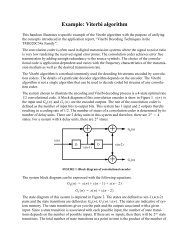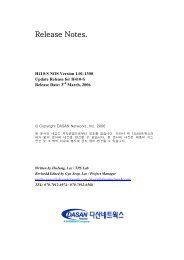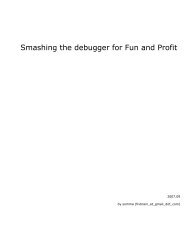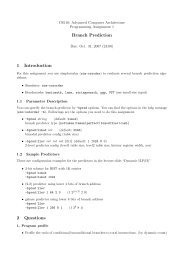"Teaching Smart People How to Learn," by Chris Argyris
"Teaching Smart People How to Learn," by Chris Argyris
"Teaching Smart People How to Learn," by Chris Argyris
- No tags were found...
You also want an ePaper? Increase the reach of your titles
YUMPU automatically turns print PDFs into web optimized ePapers that Google loves.
and implement their actions. Think of these rules as a kind of ‘‘master program’’ s<strong>to</strong>redin the brain, governing all behavior. Defensive reasoning can block learning even whenthe individual commitment <strong>to</strong> it is high, just as a computer program with hidden bugscan produce results exactly the opposite of what its designers had planned.Companies can learn how <strong>to</strong> resolve the learning dilemma. What it takes is <strong>to</strong> makethe ways managers and employees reason about their behavior a focus of organizationallearning and continuous improvement programs. <strong>Teaching</strong> people how <strong>to</strong> reason abouttheir behavior in new and more effective ways breaks down the defenses that block learning.All of the examples that follow involve a particular kind of professional: fast-trackconsultants at major management consulting companies. But the implications of my argumentgo far beyond this specic occupational group. The fact is, more and more jobs—no matter what the title—are taking on the con<strong>to</strong>urs of ‘‘knowledge work.’’ <strong>People</strong> at alllevels of the organization must combine the mastery of some highly specialized technicalexpertise with the ability <strong>to</strong> work effectively in teams, form productive relationships withclients and cus<strong>to</strong>mers, and critically reect on and then change their own organizationalpractices. And the nuts and bolts of management—whether of high-powered consultantsor service representatives, senior managers or fac<strong>to</strong>ry technicians—increasingly consistsof guiding and integrating the au<strong>to</strong>nomous but interconnected work of highly skilledpeople.<strong>Teaching</strong> <strong>Smart</strong> <strong>People</strong> <strong>How</strong> <strong>to</strong> <strong>Learn</strong> · ARGYRIS<strong>How</strong> Professionals Avoid <strong>Learn</strong>ingFor 15 years, I have been conducting in-depth studies of management consultants. I decided<strong>to</strong> study consultants for a few simple reasons. First, they are the epi<strong>to</strong>me of thehighly educated professionals who play an increasingly central role in all organizations.Almost all of the consultants I’ve studied have MBAs from the <strong>to</strong>p three or four U.S.business schools. They are also highly committed <strong>to</strong> theirwork. For instance, at one company, more than 90% of theconsultants responded in a survey that they were ‘‘highlysatised’’ with their jobs and with the company.I also assumed that such professional consultants wouldbe good at learning. After all, the essence of their job is <strong>to</strong>teach others how <strong>to</strong> do things differently. I found, however,that these consultants embodied the learning dilemma. Themost enthusiastic about continuous improvement in theirown organizations, they were also often the biggest obstacle<strong>to</strong> its complete success.As long as efforts at learning and change focused on external organizational fac<strong>to</strong>rs—job redesign, compensation programs, performance review, and leadership training—theprofessionals were enthusiastic participants. Indeed, creating new systems and structureswas precisely the kind of challenge that well-educated, highly motivated professionalsthrived on.And yet the moment the quest for continuous improvement turned <strong>to</strong> the professionals’own performance, something went wrong. It wasn’t a matter of bad attitude. Theprofessionals’ commitment <strong>to</strong> excellence was genuine, and the vision of the company wasclear. Nevertheless, continuous improvement did not persist. And the longer the continuousimprovement efforts continued, the greater the likelihood that they would produceever-diminishing returns.What happened? The professionals began <strong>to</strong> feel embarrassed. They were threatened<strong>by</strong> the prospect of critically examining their own role in the organization. Indeed, becausethey were so well paid (and generally believed that their employers were supportive andfair), the idea that their performance might not be at its best made them feel guilty.Far from being a catalyst for real change, such feelings caused most <strong>to</strong> react defensively.They projected the blame for any problems away from themselves and on<strong>to</strong> whatthey said were unclear goals, insensitive and unfair leaders, and stupid clients.Consider this example. At a premier management consulting company, the managerof a case team called a meeting <strong>to</strong> examine the team’s performance on a recent consultingproject. The client was largely satised and had given the team relatively high marks, butProfessionals embody the learningdilemma: they are enthusiasticabout continuous improvement—and often the biggest obstacle <strong>to</strong>its success.5REFLECTIONS, Volume 4, Number 2


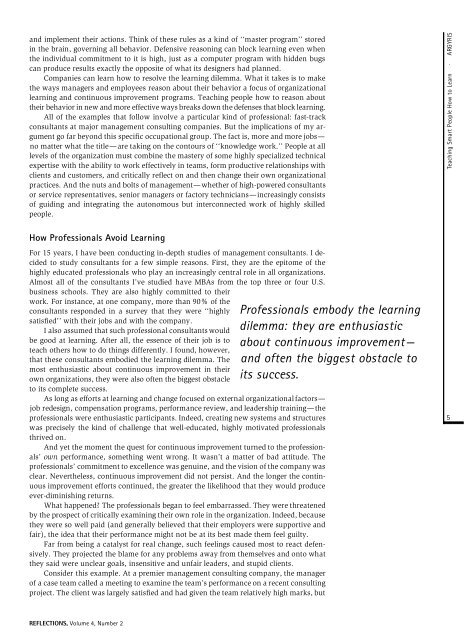

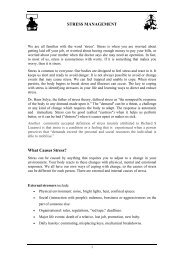

![Finale 2006 - [autumn leaves.MUS]](https://img.yumpu.com/46046993/1/184x260/finale-2006-autumn-leavesmus.jpg?quality=85)

